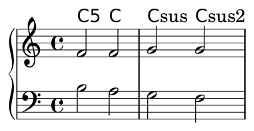Well, an example is not that easy, since what I got was a sheet with just a piano staff and a line of chords above it. It might be illustrated like this:2015-09-17 11:13 GMT+02:00 David Kastrup <address@hidden>:Thomas Morley <address@hidden> writes:2015-09-17 10:47 GMT+02:00 Simon Albrecht <address@hidden>:Hello Kaj, On 17.09.2015 09:27, address@hidden wrote:First I will declare, that I am not 100 percent sure this is a bug, but friends of mine, musicians, say it probably is. Also, as I am not an expert, I have tried to learn by searching on among others Wikipedia. It is about chords, a few of them. It started when I should clean write a score from a manuscript. In one measure there were noted two chords, C5 and C. Obviously not the same, as they stood just beside of each other. A search on Wikipedia also told me, and this was also confirmed, the author's intention, that C5 means C(no 3), hence <c g>, while the chord C means <c e g>. But LilyPond treats these two the same and produces the same notes. This is also clearly said e.g. in Appendices A.1 and A.2 of Notation Reference, as well as in the text part. However even if possibly a correct procedure, is it a correct practise? Another such discrepancy is about Csus, which Wikipedia (and my friends) says is equivalent to Csus4, hence <c f g>. But LilyPond produces <c g>, hence what should come from the notation C5 as in the previous paragraph. So, what is the truth?There are others who are more into the subject, but I may say: There is no ‘truth’. With chord names, there are so many different conventions and fiercely defended convictions that it’s impossible to define a single ‘standard’ naming scheme. (Edit: just like the NR says)Very true. It's a mess, but LilyPond can handle it. ;)Many things in the chords rendering may be overridden in LilyPond. In case you’re not aware yet, check out <http://lilypond.org/doc/v2.18/Documentation/notation/displaying-chords#customizing-chord-names> and perhaps the LSR <http://lsr.di.unimi.it>. If that doesn’t cover your wishes, you may come back with a code example, I’d suggest. HTH, Simonchrds = \chordmode { \set chordNameExceptions = #(append powerChordExceptions ignatzekExceptions) c:1.4.5 c:1.5 \notemode { <c' f' g'> <c' g'> } } << \new Staff \chrds \new ChordNames \chrdsIf it's not sufficient you can set your own 'exceptions' for chord-naming, see the links Simon provided.I think you are talking past each other. Kaj complained about how LilyPond converts \chordmode input into notes, you explain how to change LilyPond's conversion of notes to markups in a ChordNames context. We could create an exception for c:5 (like we do for c:13 which drops the 11th step). I think that's a reasonable suggestion on its surface and c:5 is not likely to be in much use exactly because it is equal to c on its own. However, it would beg the question of how to interpret c:5+ and c:5- then. Those aren't redundant. -- David KastrupObviously I still don't understand. For me the following looks as wished for Staff and ChordName context: chrds = \chordmode { \set chordNameExceptions = #(append powerChordExceptions ignatzekExceptions) c:1.5 c^3 } << \new Staff \chrds \new ChordNames \chrds@Kaj Could you provide an example to illustrade? Cheers, Harm

where C5 should mean (according to the author/composer) <c g> and Csus <c f g>.
/Kaj